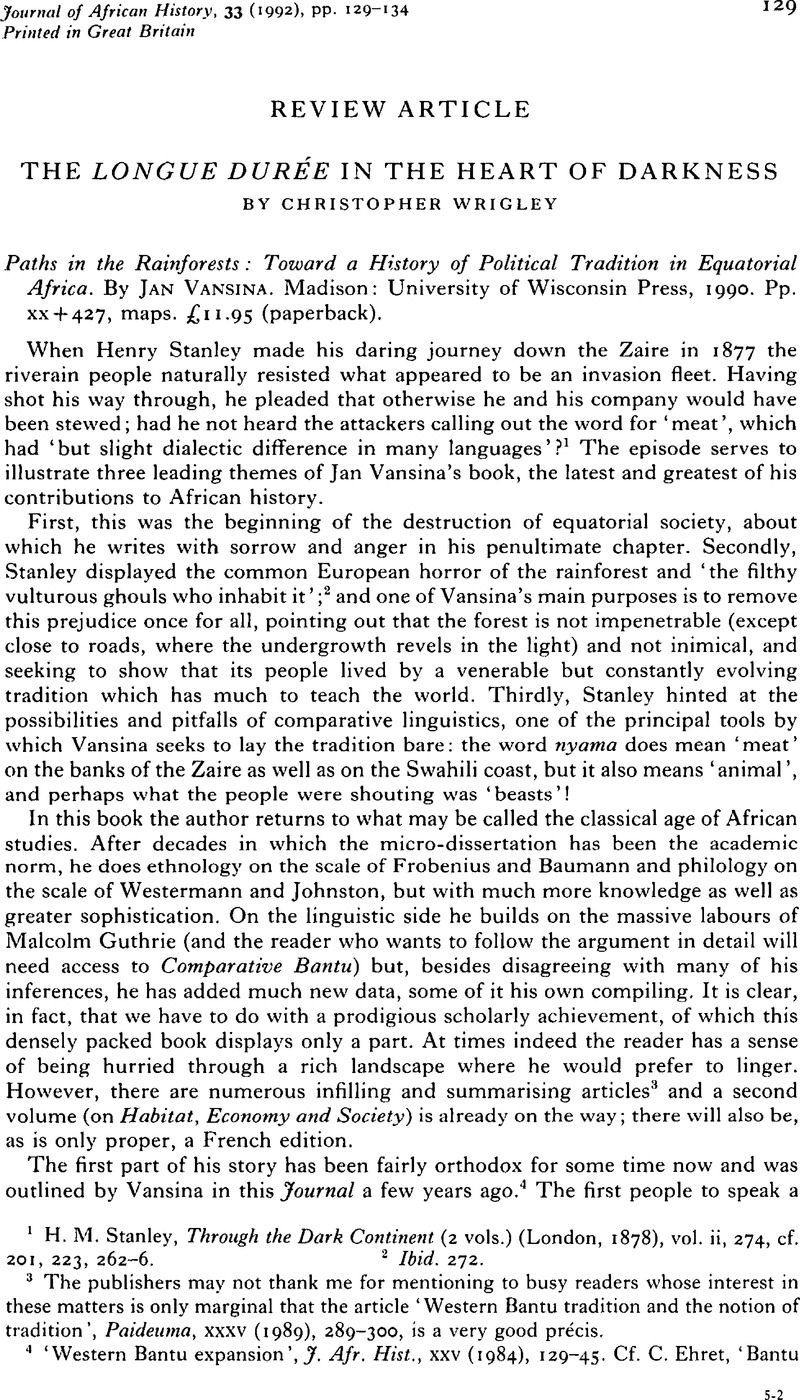Article contents
The Longue Durée in the Heart of Darkness
Published online by Cambridge University Press: 22 January 2009
Abstract

- Type
- Review Article
- Information
- Copyright
- Copyright © Cambridge University Press 1992
References
1 Stanley, H. M., Through the Dark Continent (2 vols.) (London, 1878), vol. 11, 274, cf. 201, 223, 262–6.Google Scholar
2 Ibid. 272.
3 The publishers may not thank me for mentioning to busy readers whose interest in these matters is only marginal that the article ‘Western Bantu tradition and the notion of tradition’, Paideuma, XXXV (1989), 289–300Google Scholar, is a very good précis.
4 ‘Western Bantu expansion’, J. Afr. Hist., XXV (1984), 129–45.Google Scholar Cf. Ehret, C., ‘Bantu origins and history: critique and interpretation’, Transafrican J. Hist., II (1972), 1–9Google Scholar; ‘Linguistic inferences: early Bantu history’, in Ehret, C. and Posnansky, M. (eds.), The Archaeological and Linguistic Reconstruction of African History, (Berkeley and Los Angeles, 1982), 57–65Google Scholar; N. David, ‘Prehistory and historical linguistics in central Africa’, Ibid. 78–95; Oliver, R., ‘Cameroun—the Bantu cradleland?’, Sprache und Geschichte in Afrika, 1 (1979), 7–20.Google ScholarOliver, R. and Fagan, B. M., ‘The Emergence of Bantu Africa’, in Fage, J. D. (ed.). Cambridge History of Africa, vol. II (Cambridge, 1978), 342–409Google Scholar, lacks some of the newer information but is on basically similar lines.
5 Ehret, C., ‘Patterns of Bantu and Central Sudanic settlement in central and southern Africa (ca. 1000 BC–500 AD)’, Transafrican J. Hist., III (1973), 1–71Google Scholar; Heine, B., ‘Zur genetischen Gliederung der Bantu-Sprachen’, Afrika und Übersee, LVI (1973), 164–85Google Scholar; Bennett, P. R. and Sterk, J. P., ‘South-Central Niger-Congo: a reclassification’, Studies in African Linguistics, VIII (1977), 241–73.Google Scholar This division is also evident in Henrici, A., ‘Numerical classification of Bantu languages’, African Language Studies, XIV (1973), 82–104Google Scholar, and Bastin, Y., ‘Essai de classification de quatre-vingt langues bantoues par la statistique grammaticale’, Africana Linguistica, IX (1983), 11–108.Google Scholar
6 Bastin, Y., Coupez, A. and de Halleux, B., ‘Classification lexicostatistique des langues bantoues (214 relevés)’, Bulletin de l'ARSOM, XXVII (1981), 173–99.Google Scholar
7 Sutton, J. E. G., review, Nyame Akuma, XXVI (1985), 44.Google Scholar
8 de Maret, P., ‘Recent archaeological research and dates from central Africa’, J. Afr. Hist., XXVI (1985), 129–48CrossRefGoogle Scholar; Clist, B., ‘Early Bantu settlement in west-central Africa’, Current Anthropology, XXVIII (1987), 380–2CrossRefGoogle Scholar; Locko, M., ‘La recherche archéologique à l'Université Omar Bongo’, Muntu, VIII (1988), 26–41Google Scholar; Denbow, J., ‘Congo to Kalahari’, Afr. Arch. Rev., VIII (1990), 139–76.CrossRefGoogle Scholar
9 ‘Cameroun—the Bantu cradleland ?’. The reference is to movement within the forest zone, not to the discredited notion of a ‘quick dash’ through it.
10 Williamson, K., ‘Indigenous languages of the Niger-Benue confluence region’, Muntu, VIII (1988), 45–53.Google Scholar
11 Vansina, , Paths, 268.Google Scholar See Guthrie's CS 657–9, 664–5, 709, 714.
12 Paths, 268. Guthrie's CS 1263–5. And see E. A. and Ruskin, L., Lomongo Dictionary (London, n.d.)Google Scholar, suv. -kuma and -kumya.
13 Stas, J. B., ‘Les nkumu chez les Ntomba de Bitoro’, Aequatoria, II (1939), 109–23Google Scholar; cf. Brown, H. D., ‘The Nkumu of the Tumba’. Afrika, XIV (1944), 431–47CrossRefGoogle Scholar, and Sulzmann, E., ‘Batwa and Baoto; die Symbiose von Wildbeutern and Pflanzern bei den Ekonda und Bolia’, SUGIA, VII (1986), 369–89.Google Scholar
14 Vansina, J., ‘Is elegance proof? Structuralism and African history’, History in Africa, x (1983), 307–48.CrossRefGoogle Scholarde Heusch, L., Essais sur le symbolisme de l'inceste royale en Afrique (Brussels, 1958)Google Scholar; ‘Aspects de la sacralité du pouvoir en Afrique’, Annales du Centre d'Etude des Religions, I (Brussels, 1962)Google Scholar; Le roi ivre ou l'origine de l'Etat (Paris, 1972).Google Scholar
- 3
- Cited by




